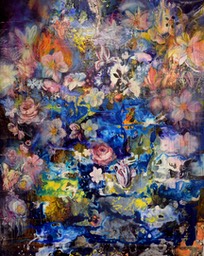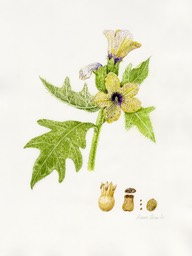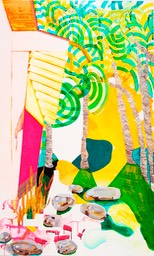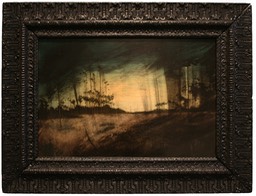Carol Jazzar speaks about the exhibition entitled "Into the Wild," that she curated for Miami-Dade College's Kendall Campus.
‘Into the Wild’ exhibit at MDC Kendall Campus explores forces of nature BY GEORGE FISHMAN
With its focus on the “old-fashioned” theme of nature — flowers, palm trees, rolling hills and rainstorms — Into the Wild, curated by Carol Jazzar, stands out in an exhibition landscape regularly dominated by conceptually based art. That’s especially true as South Florida ramps up for Art Basel’s onslaught of the hippest and most collectible offerings.
But, the theme of nature — specifically environmental controversy — clearly has currency. It’s a recurring topic for political cartoonists, presidential debate and letters to the editor. It’s also currently addressed by other artists around town: Jim Couper at the Frost Art Museum, Xavier Cortada in Clima at Hialeah’s Milander Center for Arts and Entertainment and Robert Huff at Miami Dade College’s Museum of Art and Design, to name three.
Eco-politics — global and local — were certainly central to Jazzar’s choice of subjects. “The theme of nature is important right now because we’re at a crucial time with the environment,” she said. “We need to remember and realize that nature is beautiful and precious and is endangered. And it’s endangering us, also.”
But nature is not only a universal theme, it’s also personal for Jazzar. “It’s a painting show of nature, and I chose that theme, because I thought about my childhood in the country, and it was a time of innocence and happiness. So maybe unconsciously I wanted to revisit that time.”
Jazzar was raised in France’s Brittany region, and she recently described the giant oak tree behind her childhood house as a sanctuary from the normal conflicts of growing up. After moving to the United States more than 20 years ago, she purchased a home in El Portal, just north of the city of Miami, that was especially appealing for its spacious yard, lush with subtropical foliage and fruit trees.
In a pioneering venture, she operated a highly respected gallery in her home and a converted garage, until early this year. Although the art she presented included every imaginable form, technique and theme, the connection between the creative spirit and the sensual stimulation of the natural world that enveloped her exhibition venue was vital. Take a breath and smell the different fragrances. Listen to the rickets — and occasional mosquitoes, she coaxed a visitor. “We are in the heart of the city, but still it’s like being in the country.”
The large, high-ceilinged and chilly white space of Miami Dade College’s Kendall Campus Gallery is a far cry from the intimacy of Jazzar’s El Portal garden, but the 19 artworks by 10 artists generate sanctuary from the surrounding concrete and commotion.
Students and faculty provide the exhibition’s principal audience, which is important both to Jazzar and to Wanda Texon, director of MDC Campus Galleries.
“With a guest curator,” Texon said, “students get to see someone else’s take on a topic.” As a former art historian, she was particularly excited that Jazzar was able to borrow a pair of 19th-century works to juxtapose with those by contemporary artists.
“Over the years I’ve been interested in artists depicting nature in innovative materials or innovative vision, and that’s what the show’s about,” Jazzar said.
“We have 10 artists; eight of them are contemporary. Most of them live here in South Florida [notably, many have local gallery representation], and they all use nature as the theme of their work. But they use different techniques. The way they see nature or the way they see the environment is different.”
Jazzar was already curating the Robert Huff survey/retrospective for MDC’s Museum of Art + Design when an opportunity presented itself at the Kendall campus gallery. She was prepared, knowing which artists to include. It was primarily a matter of selecting individual works that were available and that would illustrate and amplify the theme.
According to Texon,“When we met at the gallery a few times, she looked around and was kind of placing things right there on the spot — in her mind. She knew what she wanted.”
This subject matter is universally recognizable, even to inveterate city dwellers.
To Texon’s surprise and delight, more than 100 students came to the September artist talk, and many of them brought sketch pads to literally draw inspiration from the works on view. Texon has been on staff for 10 years, working in the college galleries, and this is the first show of its kind that she recalls.
The exhibition offers some works that command a distant view by their large scale, texture, bold color and graphic impact, for example Lilian Garcia-Roig’s “chewy” north Florida palmetto palm thickets; Elisabeth Condon’s O’Keeffe-inspired Interior of A Flower; Ernesto Kunde’s luminous mangroves and the wet floral meltdown of Magnus Sodamin’s Water Garden.
At the other extreme are Scott Armetta’s diminutive spooky paintings that draw the viewer into an unnerving drama of nighttime fires.
This is not to suggest the exhibition is limited to a binary of large and small; striking and monochromatic. The exhibition is finely nuanced — in the selection of works, their judicious placement and the mastery of composition and diverse paint handling.
Jazzar has been a longtime fan of Lilian Garcia-Roig.
“She’s a plein-air painter, so she goes into the woods early in the morning and spends the entire day there. She depicts what she sees, and it’s really lush and fuzzy and wild, and you can see it in her painting,” Jazzar said.
“She uses a lot of paint. It’s both abstract and figurative work. Because when you’re up close, it’s only big blocks of paint on the canvas. Her canvases are really thick, really charged with paint; it’s only when you look back that you can see, ‘Oh yes, it’s a forest, or it’s the Everglades.’ ”
Sodamin’s poured paint generates marbling effects in a meandering flow that suggest depths of possibly toxic water, from which myriad blooms emerge, all clamoring for attention. Few appear freshly picked. As Jazzar said, “They’re almost like decomposing on the canvas.” But look for the incongruous insertion of an apple, hiding in plain sight about seven feet off the floor. Edible?
Morningside Morning, from 2010, combines Condon’s longtime interests in architecture and in the sensuality of floral forms — as in her Interior of a Flower, also on view. Here, she evokes the setting of a mid-century home by sketching in a wall and rafters.
Its spare lines and planes contrast both with the adjacent palm tops, abstracted to a cluster of concentric rings, and with the exaggeratedly scratchy bark of the trunks that hold them aloft. Wiggly spears of Sanseviaria — a quintessential 1950s border plant — and a set of gray ovoid landscape rocks complete the picture. Warm and cool, opaque and translucent, curvilinear and planar treatments strike a surprising balance.
Typoe has been a foundational figure in Miami’s graffiti and mural community for more than a decade, but he also creates sculpture with found objects and works with neon, magnets and even explosives. His Untitled (Floral II) is from a 2013 series of flower “paintings.” They’re surprisingly realistic and reminiscent of East Asian Sumi-e painting masters’ thousand shades of gray. But close examination reveals, instead of ink, the powdery, granular and crystalline materials from which this “old-fashioned” illusion is alchemically formed. In a sequence of carefully controlled “burns,” the artist ignites gunpowder, previously mixed with pigment and tone-determining adhesives (stick glue for lights; gel medium for darks) and applied to heavy Fabriano paper. During nine years of experimentation, he has developed both specialized equipment and specific techniques to manage the visual effects and reduce hazards.
“There’s a process,” he said, “a physical process. It’s exciting, it’s tiring, it is painful; it is everything that you want in art . it’s life.” Currently, he has a waiting list for commissions.
Donna Torres’ work is presented as a large 24-panel grid, but these highly detailed 12- by 8-inch botanical illustrations were commissioned as a book project — one plate per page.
Jazzar explained, “She is doing the work of the early herbalists who were cataloging species, so she takes a leaf and the seed of that plant and the flower of that plant and she composes her page … very meticulous.” And they’re executed in watercolor, a very unforgiving medium.
Torres bridges the contemporary treatments of her colleagues with those of prior centuries — specifically two Cuban artists from the mid-1800s, Miguel Arias and Augusto Chartrand Dubois.
“Before the impressionists, nature was depicted in the background of paintings,” Jazzar said. When you see the Mona Lisa, you see the figure and you see landscape but it’s in the background. It’s just support for what’s in the foreground.”
Dubois’ image of a modest country home features — notably — a pair of black figures in the foreground; he’s on horseback, she strides beside him, carrying laundry. A windy rain squall sweeps through the middle distance, shaking even the massive oak trees, but above the clouds, bright blue sky appears, allowing a shaft of light to illuminate the roadway. Figures are present, but it’s the landscape that expresses drama, much as a turbulent renaissance figurative scene might be echoed by a storm.
The exhibition consists of individual works, but their arrangement is critically important. As in a musical composition, solo voices may alternate with various ensemble expressions. Jazzar gives large, “loud” works ample space to express themselves and also creates revelatory groupings. The Armetta, Dubois and Condon wall is especially successful. As Jazzar put it, “The visual construction of each painting is similar,” even though each is unquestionably distinctive.
Some works are displayed to encourage side-by-side comparison; others speak across the room or in a string of contrasting assertions, such as those between three brooding, mysterious Armetta paintings and the whirling, fanciful works of John DeFaro that flank them.
Paired with Garcia-Roig’s large Palm Menagerie, a juicy web of chunky paint that immerses the viewer in a thicket, Ernesto Kunde’s work might first appear simplistically flat. Instead, its startlingly glowing turquoise enfolds the distinctive black silhouette of mangrove branches, roots and leaves. His judicious use of burnt orange stains, star-like spots of white and small patches of pale green spray paint create an enveloping wetlands Nocturne.
Wilderness is a place “out there,” but also a description of psychological dynamics. As Jazzar said, “People may fall into the wilderness of chaotic impulses, but on the other side there is the wilderness of innocence. It’s a reminder of all that: the beauty, the power of nature, the fragility of nature and the fragility of our nature and our own being. Nature will always be here. Us, I’m not so sure.”
Read on Herald site: http://www.miamiherald.com/entertainment/visual-arts/article41377077.html#storylink=cpy



